Affiliate links on Android Authority may earn us a commission. Learn more.
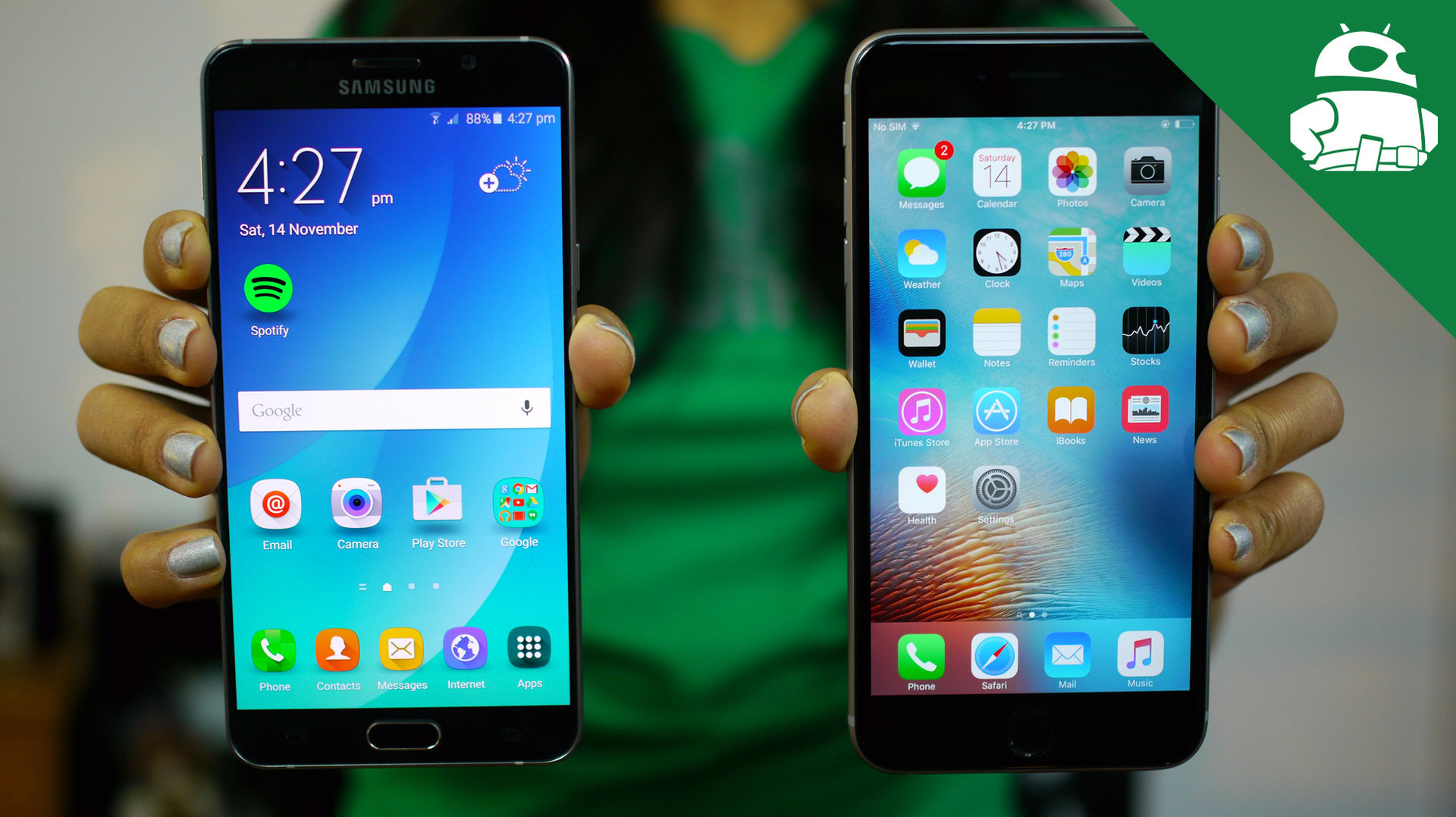
Galaxy Note 5 Samsung
What we like
What we don't like
Galaxy Note 5 Samsung
Samsung and Apple undoubtedly dominate the global smartphone market and they are responsible for some of the most popular mobile devices out there. There has been no shortage of accusations of copying and “inspiration” from either camp, but with Samsung doing away with a couple of key features, and Apple giving into the large display trend that is more or less a standard in the Android world, what we have with their latest smartphone offerings are two devices that appear to be quite similar.
Despite their similarities on the surface however, when diving in a little deeper, these two devices couldn’t be more different. How does the current Samsung flagship fare against the latest large display smartphone from Apple? We find out, in this in-depth look at the Samsung Galaxy Note 5 vs iPhone 6S Plus!
Design
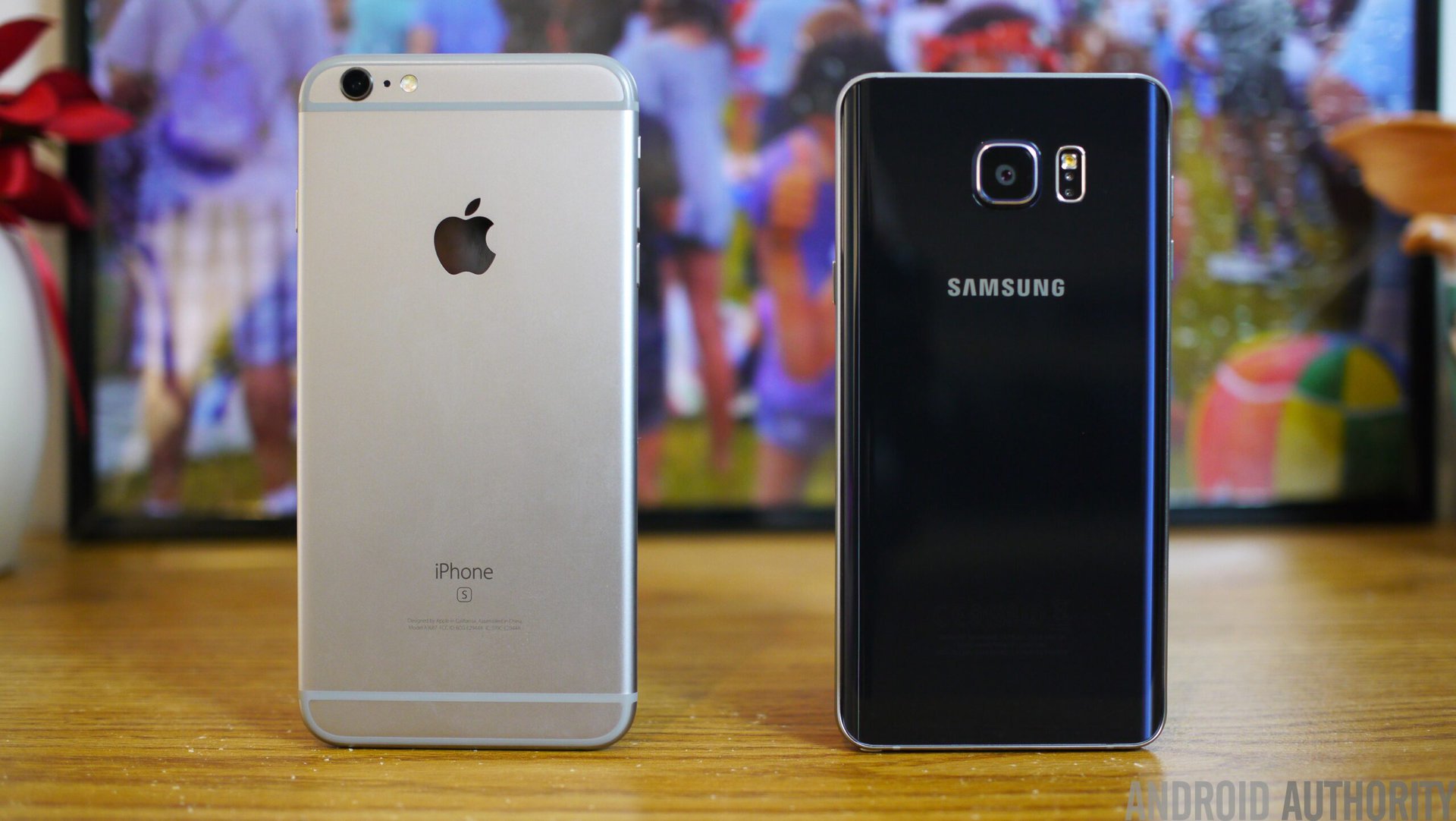
Premium design and build quality are the order of the day with both smartphones, and while that has always been the case with the iPhone, we see a dramatic departure on the part of Samsung, with plastic finally going by the wayside, in favor of a metal and glass unibody design. This choice by Samsung does result in the removal of some features that were taken for granted, like expandable storage and replaceable batteries, and is another reason for the increasing similarity between these two smartphones, given that these features were never a part of the Apple ecosystem.
Given that this an “S” year, the iPhone 6S Plus features the same design language as the iPhone 6 Plus before it, but unlike previous generations, where the successor had generally been thinner and lighter, the iPhone 6S Plus is actually slightly thicker and heavier than its predecessor. This is because the device is now made with a stronger 7000 series aluminium, to help avoid any “Bendgate” issues, and there is also an additional pressure sensitive layer below the display, needed for the phone’s new 3D Touch feature.
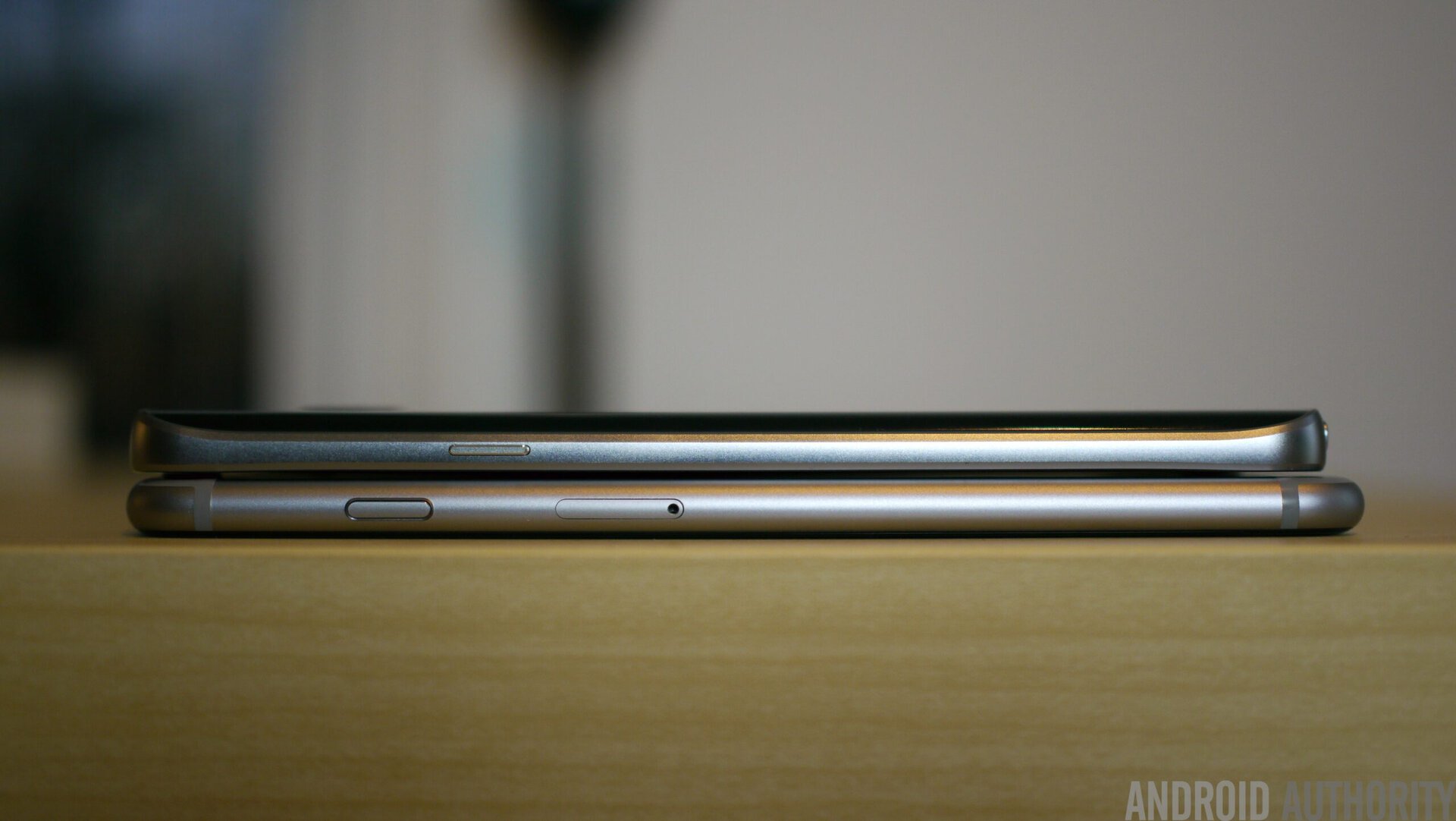
As mentioned, the iPhone 6S Plus features a full metal body, while the Galaxy Note 5 sees its premium nature with a combination of a metal frame sandwiched between two glass panels. Both smartphones look beautiful in their own right, and it does, of course, depend on your individual preferences as to which looks better. What is key here, especially when considering the size, is the feel in the hand, and both devices have their pros and cons. Both material choices result in quite the slippery device, and the use of glass in the case of the Samsung flagship means that it is also a fingerprint magnet.
Despite the Galaxy Note 5 featuring a larger 5.7-inch display, compared to the 5.5-inch screen of the iPhone 6S Plus, the former actually manages to be slightly smaller and lighter than the latter, even if the iPhone 6S Plus is a touch thinner. Of course, both devices are still too big for comfortable one-handed use, but Samsung has to be given points here for creating a relatively more compact device. Also helping the handling experience of the Galaxy Note 5 are its sharper edges, compared to the more rounded corners and side of the iPhone, along with the fact that the rear glass panel comes with curves along the sides, that help the device feel more secure in the hand.
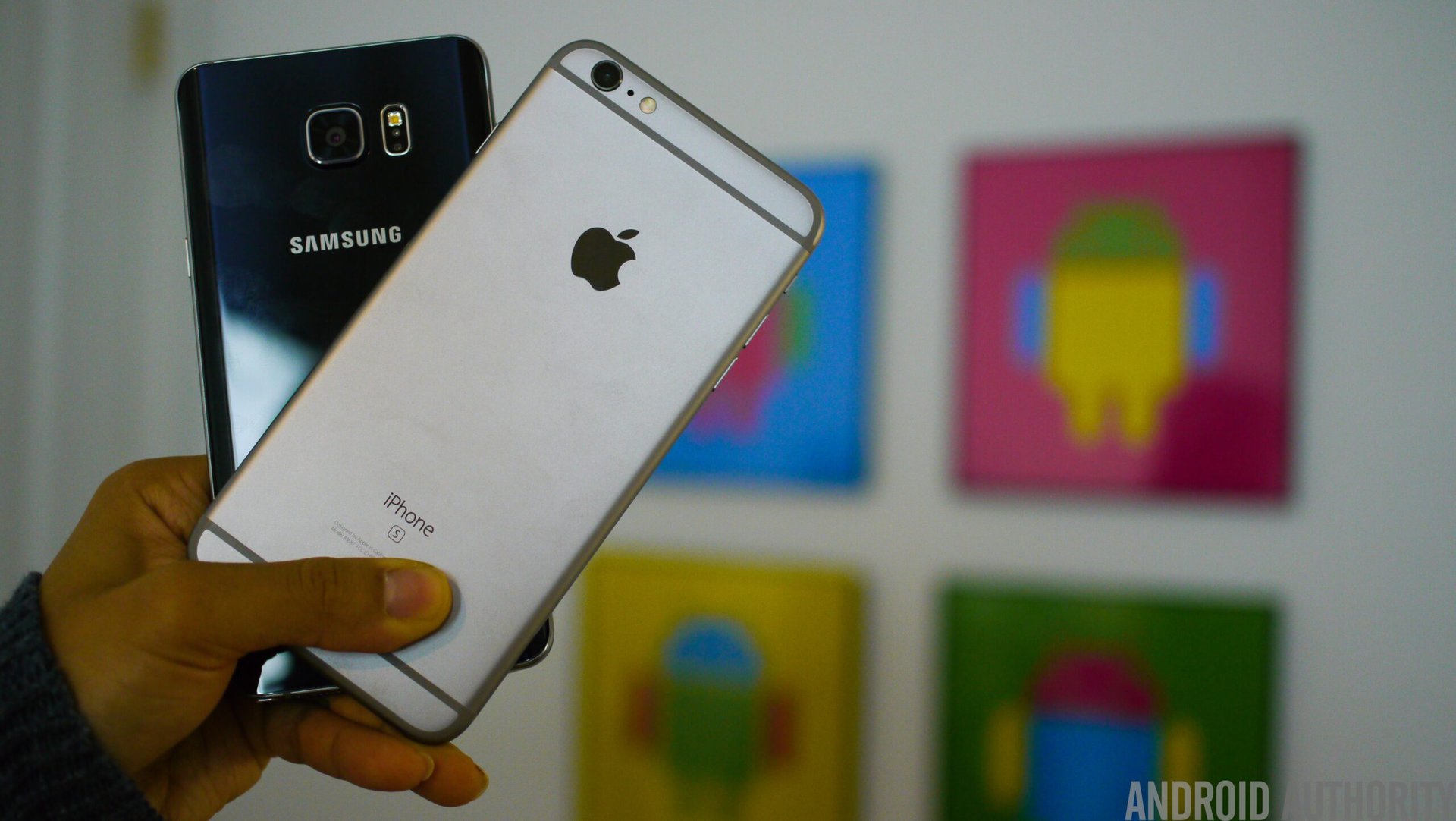
The similarities in design continue when looking at the layout of the buttons and ports, with the volume rocker on the left side and the power button to the right in both cases. The power button of the iPhone 6S Plus does seem to be on the higher side however, making it a touch harder to reach. At the bottom is the charging port, microUSB in the case of the Galaxy Note 5 and the Lightning port with regards to the iPhone 6S Plus, flanked by the headphone jack and a single speaker unit. In differences, the Galaxy Note 5 does comes with the S-Pen stylus that is nestled into the bottom right side, and the iPhone 6S Plus features a silence toggle above the volume rocker, allowing for a very simple way to quickly silence the device.
Display
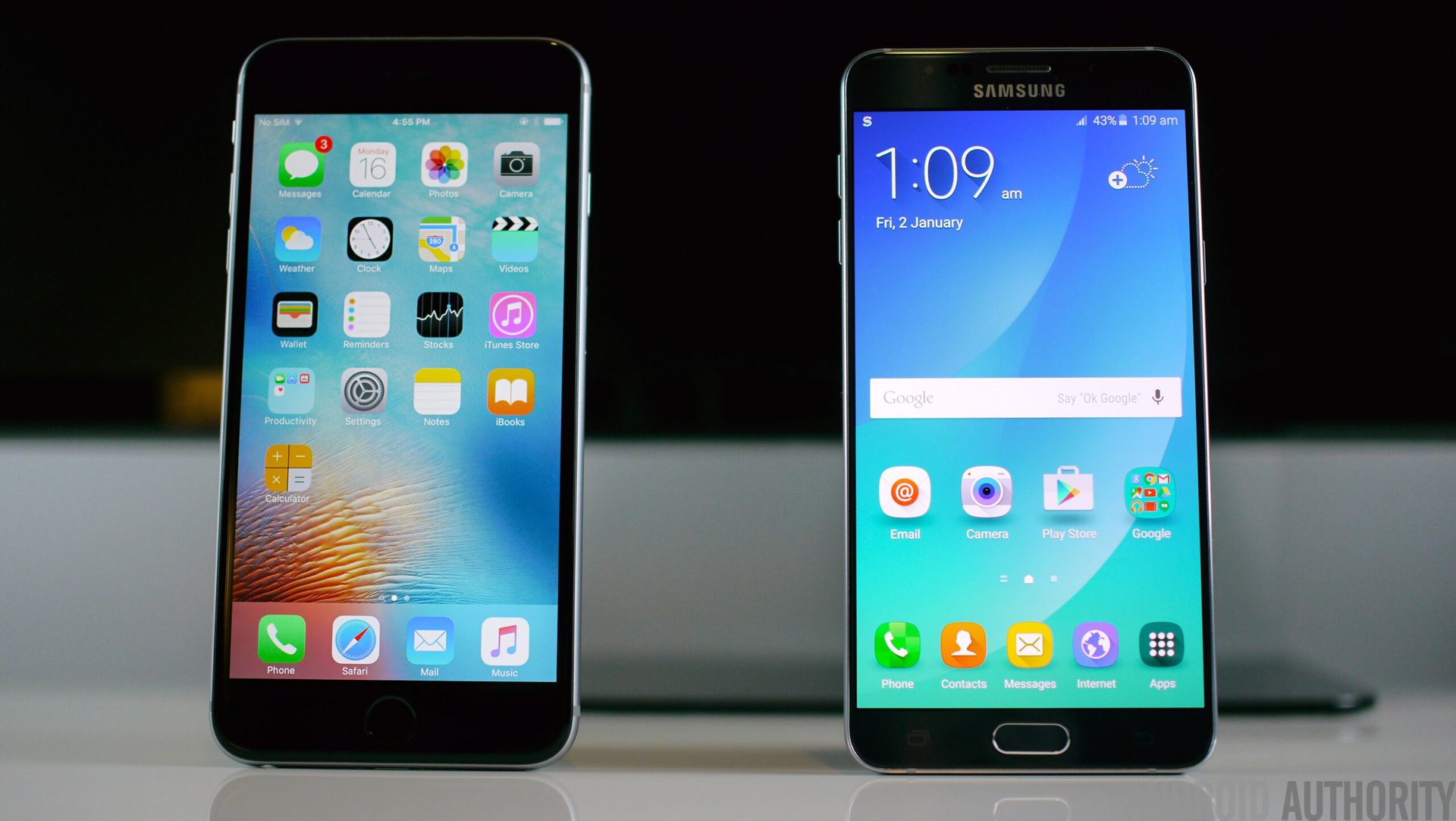
The big difference between the two smartphones can be seen when it comes to the display, not only with regards to the size and resolution, but also their respective underlying technologies. While the Samsung Galaxy Note 5 comes with a 5.7-inch Super AMOLED display with a Quad HD resolution, resulting in a pixel density of 518 ppi, the iPhone 6S Plus features a 5.5-inch IPS LCD screen with a 1080p resolution, resulting in a lower pixel density of 401 ppi.
Despite the difference in resolution and pixel densities, there isn’t a whole lot of difference between the two displays in terms of clarity, but a contrast can be seen because of the different technologies. As is now expected from Samsung displays, Super AMOLED allows for deep blacks, high contrast, and colors that pop, with the higher resolution only further enhancing an enjoyable viewing experience. Of course, the screen of the iPhone 6S Plus is plenty vivid and bright as well, and the display experience available with it is almost equally as good.
Performance
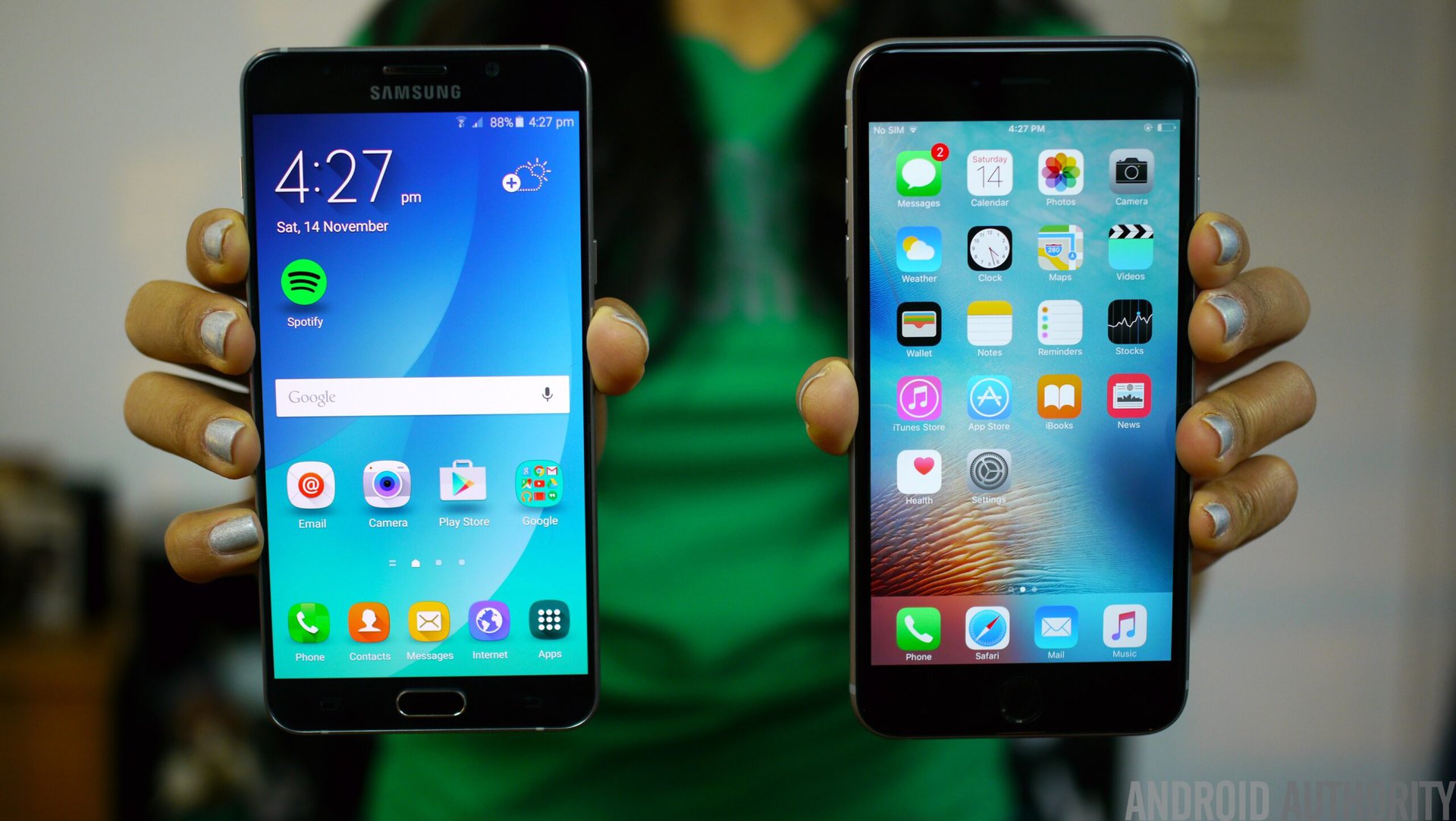
The Samsung Galaxy Note 5 comes with an octa-core Exynos 7420 processor, clocked at 2.1 GHz, and backed by the Mali-T760MP8 GPU and 4 GB of RAM, while the iPhone 6S Plus features a dual-core Apple A9 processor, clocked at 1.84 GHz, and backed by the PowerVR GT7600 GPU and 2 GB RAM. However, a by the numbers comparison is never fair when comparing Android and iOS flagships, given the two very different ecosystems that are being catered to, and despite any differences on paper, the performances of both devices are quite comparable.
In either case, both smartphones handle daily tasks with ease, and anything from opening, closing, and switching between apps, to browsing the web and media consumption are done with no issues. Gaming and multi-tasking are a breeze as well, even with the Galaxy Note 5 offering a lot more ways of multi-tasking compared to the iPhone 6S Plus, by also taking advantage of the S-Pen stylus. Games load really fast with both devices, albeit a touch faster in the case of the iPhone 6S Plus, but once loaded, everything is equally smooth and snappy.
The argument with regards to how much more powerful high-end Android devices are compared to the iPhones is unending, but as far as day to day performance is concerned, you will have a wonderful time getting work or play done on either smartphone.
Hardware
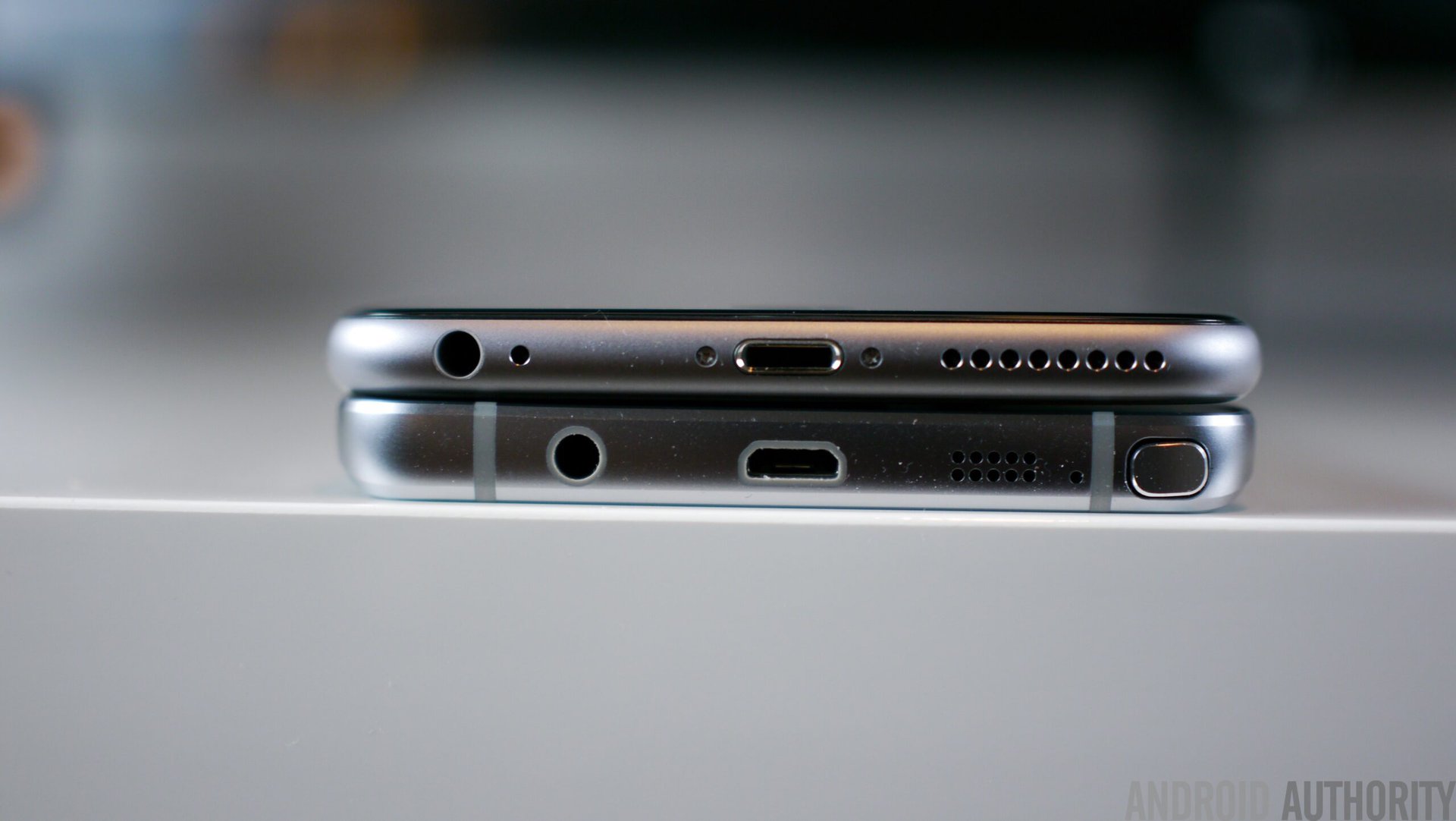
With Samsung removing key features like expandable storage and replaceable batteries to accommodate their new design language, things have never been more similar between the two ecosystems than now in terms of hardware.
Both smartphones come with fingerprint scanners integrated into the physical home buttons up front, but the iPhone 6S Plus does get the leg up with Touch ID being faster than ever. The fingerprint sensor is actually a little too fast, which is definitely an odd complaint to have, but if you are trying to take a look at the notifications on the lockscreen in the gap between pressing the button to turn on the display and the device unlocking, you will likely not be able to. The obvious work around here is to use the power button to wake the device first before unlocking it, but given its slightly difficult to reach position, it isn’t the best solution. That’s not to say that the scanner of the Galaxy Note 5 is particularly slow either, but some may actually prefer the extra time it takes to allow for a quick glance at the notifications.
32 GB and 64 GB storage options are available with the Galaxy Note 5, while the iPhone 6S Plus comes with 16 GB, 64 GB, and 128 GB iterations. With expandable storage not available with both, power users will have to opt for the higher storage versions, even though you will end up paying a significant premium. As mentioned, both devices also come with single bottom-mounted speakers, and while the placement isn’t ideal, both get plenty loud. The speaker of the iPhone 6S Plus does seem a bit clearer, with the Galaxy Note 5 speaker tending to compress the sound a little too much, even if that does help certain sounds come through a bit more.
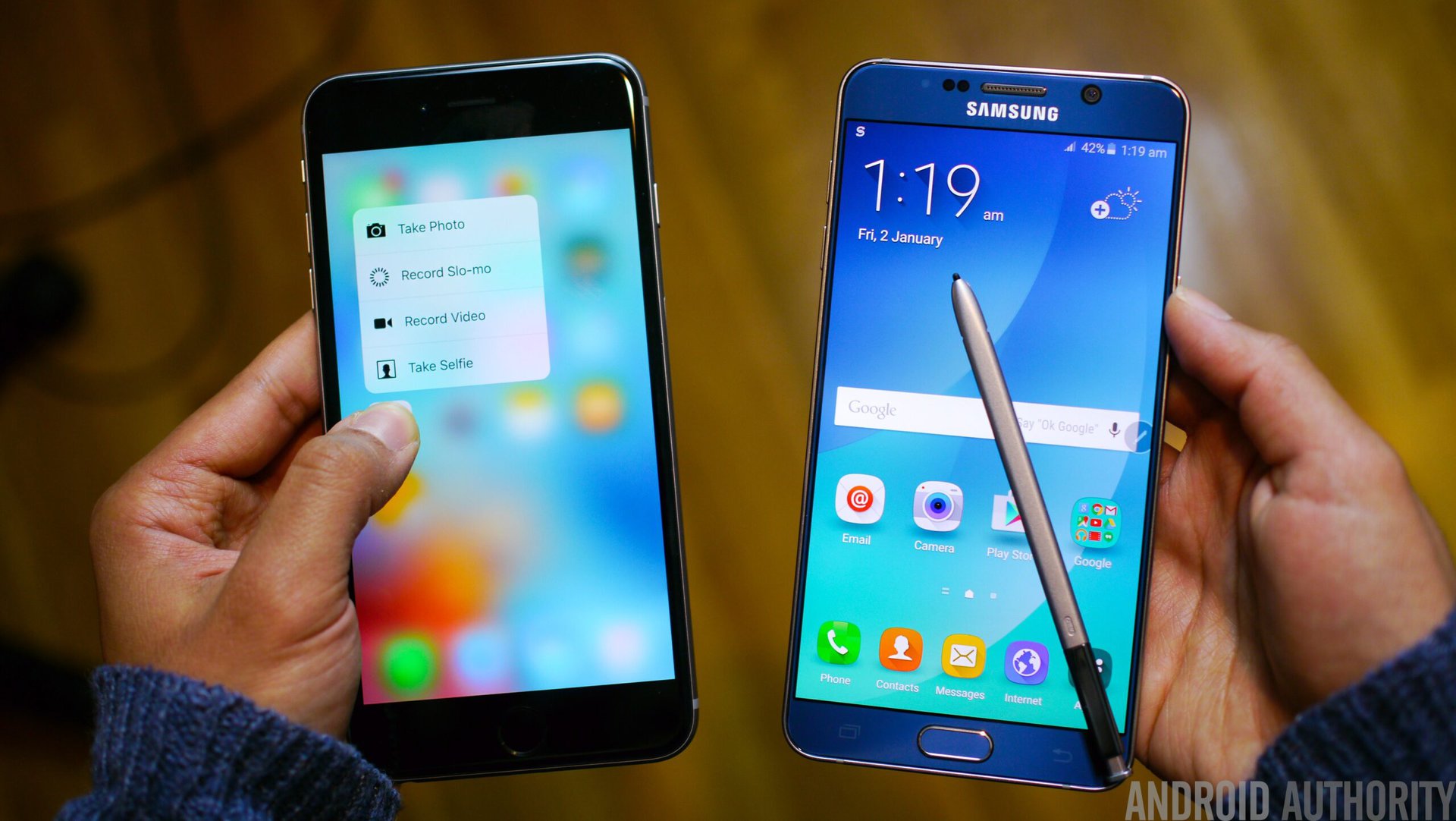
Both smartphones come with a standard suite of connectivity options, including NFC, but in the case of the iPhone 6S Plus, NFC is locked for use only with Apple Pay, while in the case of the Galaxy Note 5, you can use it for anything, including, but not just limited to, Samsung’s and Google’s own mobile payment systems, Samsung Pay and Android Pay. Samsung Pay does have the edge over Apple Pay however, with it possible to use the former almost anywhere with its use of Magnetic Secure Transmission, which works by sending a small magnetic signal from your smartphone to a credit card reader, basically mimicking the same signal that is produced when you swipe your card.
Each smartphone does have an ace up their sleeve however. In the case of the Galaxy Note 5, it comes in the form of the S-Pen stylus, boasting an even more robust set of features. You can now quickly make a note simply by taking the S-Pen out of its slot, even when the display is off, crop areas of screenshots and take notes on it, and also capture long screenshots by capturing long passages and stitching them together. The Galaxy Note 5 makes jotting down ideas and sharing them effortless, and can be a lot of fun. Other hardware extras of the Galaxy Note 5 include the heart rate monitor, found next to the camera unit on the back, which allows for a quick way to keep track of your heart rate during a workout.
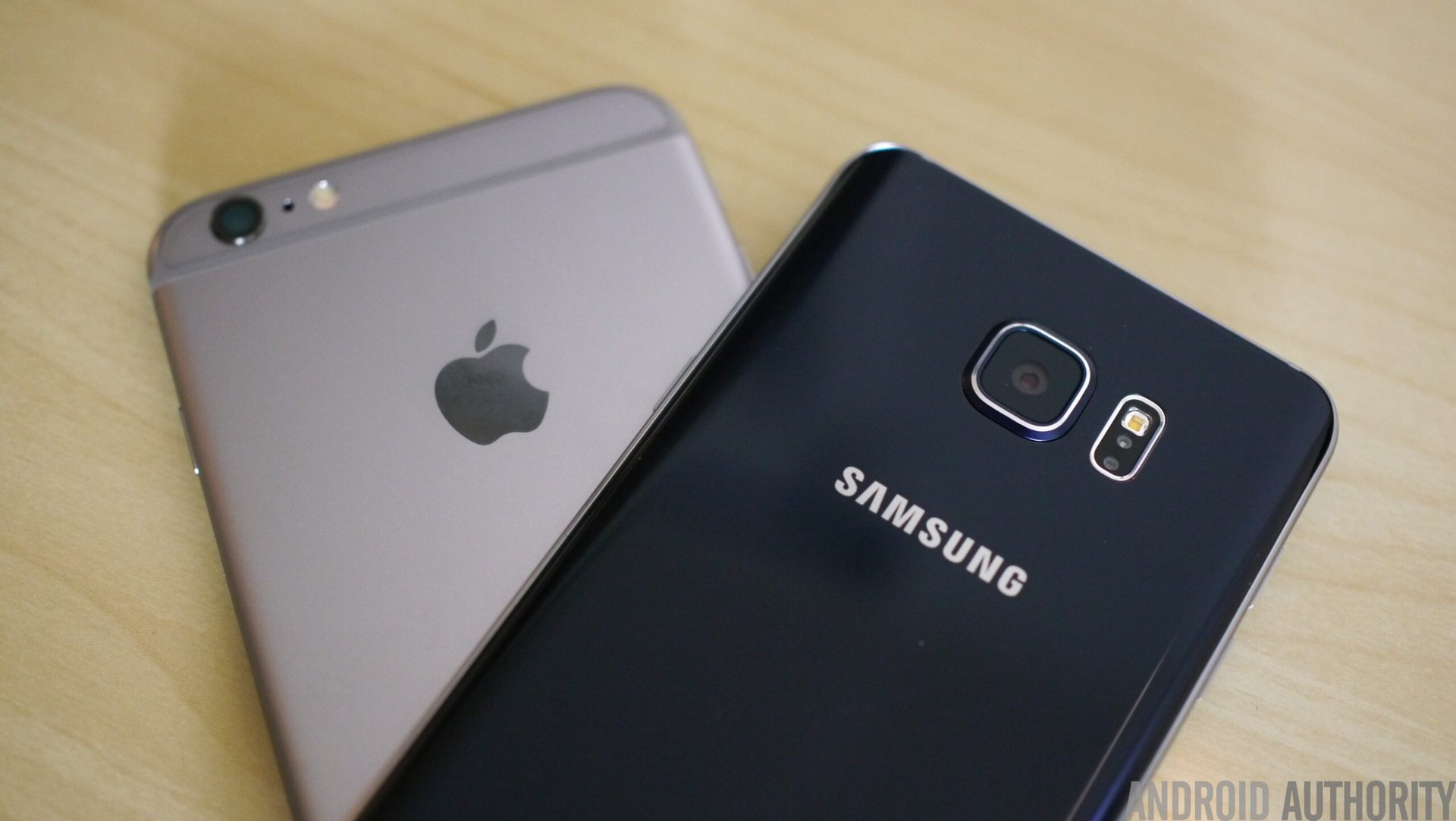
As for the iPhone 6S Plus, we get a new technology called 3D Touch, which uses a pressure-sensitive layer below the display, that allows for hidden menus to be shown when pressing on something like an app icon with a bit more force. This helps keep the menus and homescreens looking clean, while adding a lot of functionality, such as Peak and Pop, which allows for a preview of something like an email or an image, and using a little more force will then take you into the full image. 3D Touch is certainly a great addition, and could prove to be a game changer for the industry.
Finally, in battery, the iPhone 6S Plus packs a 2,750 mAh unit, while the Galaxy Note 5 features a larger 3,000 mAh battery. Both devices feature better than average battery life, and you should comfortably get a full day of use out of either smartphone, if not more. That said, the Samsung Galaxy Note 5 has its advantage in the form of its fast charging capabilities, that allows for a full charge in just around an hour and fifteen minutes, while the iPhone 6S Plus does tend to take a lot longer. The Galaxy Note 5 also comes with wireless charging, which Samsung claims is the fastest iteration that is currently available.
Camera
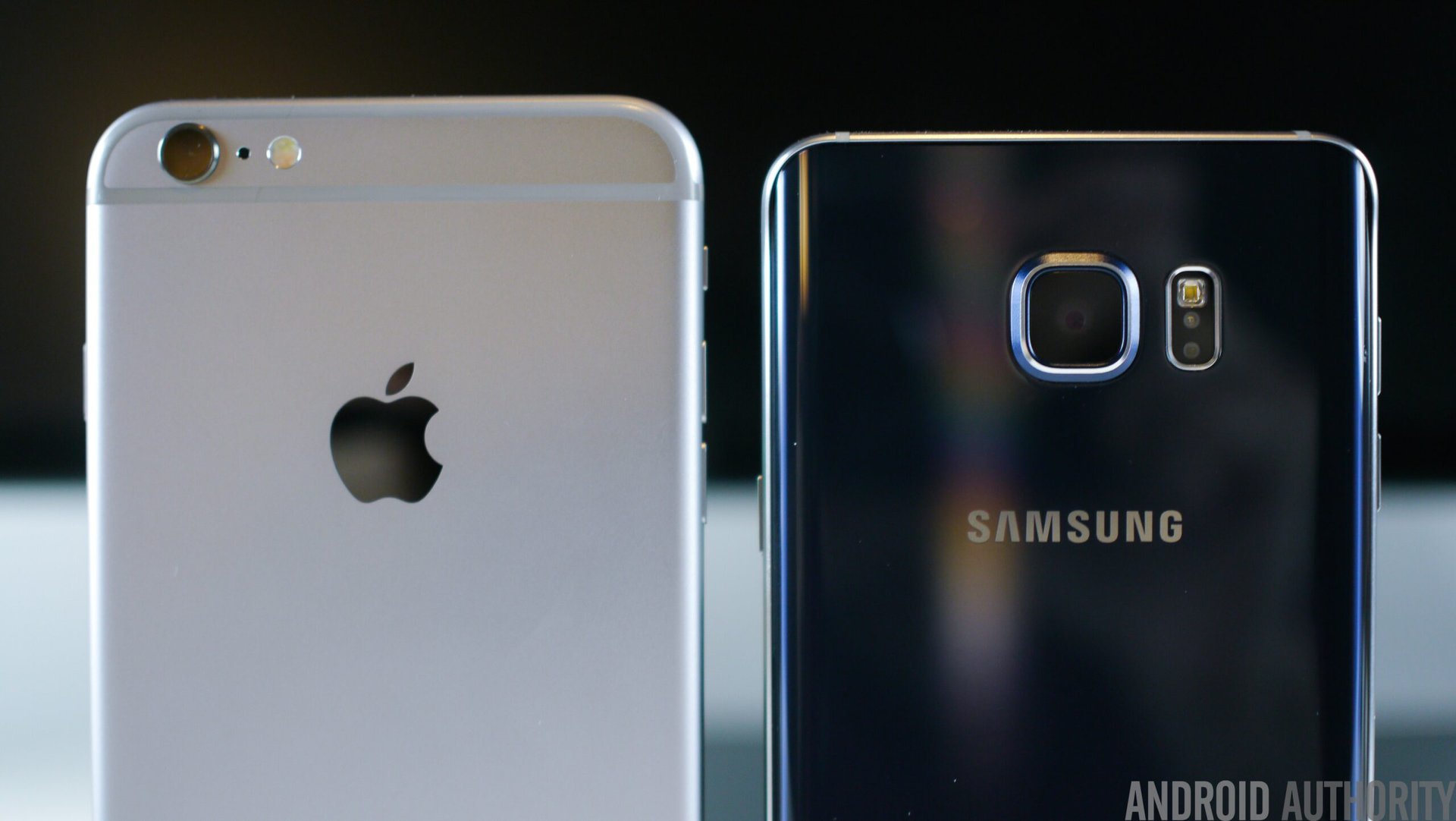
Moving on to the cameras, the Galaxy Note 5 comes with a 16 MP rear shooter with a f/1.9 aperture, OIS, and 4K video recording capabilities, along with a 5 MP wide angle lens front-facing camera, while the iPhone 6S Plus camera has been upgraded to a 12 MP primary shooter with a f/2.2 aperture, and also comes with OIS and 4K video recording, as well as a 5 MP front-facing unit.
Taking a look at the camera applications first, both apps are designed to be very simple and be fantastic automatic shooters, so if you are looking to just point and shoot for a great shot, either camera will do. The iPhone 6S Plus camera app focuses on being a great automatic shooter, with only a few modes available, like time lapse, hyper lapse, and slow motion. On the other hand, the Galaxy Note 5 does bring a lot more to the table, with plenty of modes, including its own slow motion capture, panorama, and even a GIF creator, and also features a robust set of manual controls in the Pro mode, allowing for granular control over aspects like white balance and ISO.
Samsung Galaxy Note 5 camera samples
As far as image quality is concerned, you are going to be hard-pressed to pick a winner between the two the majority of the time. Both offer sharp details and nice colors, but the overall theme here is that you will get more realistic colors and less sharpening with the iPhone 6S Plus, while the images feature more saturated colors and more sharpening with the Galaxy Note 5. Of course, that doesn’t mean that the iPhone 6S Plus camera is better, as many would prefer the extra pop in colors available with the other. The same can be said for video capture as well, with it being hard to make a choice between the two. While the Galaxy Note 5 adds some software enhancements, the iPhone 6S Plus does create a flatter, and more accurate, video.
iPhone 6S Plus camera samples
The lower aperture of the Galaxy Note 5 allows for better looking close up shots with some nice depth of field, as well as better low-light photography. It is also great the Galaxy Note 5 allows for shooting in the 16:9 aspect ratio with their full sensor, while the iPhone 6S Plus shoots at 4:3 with its full sensor. When it comes to the front-facing camera, the Galaxy Note 5 does hold the edge with its wide angle lens, that allows for a lot more to be fit into the frame. That said, the camera app does tend to smooth out the skin a bit too much, even with Beauty Mode off, which is a little annoying.
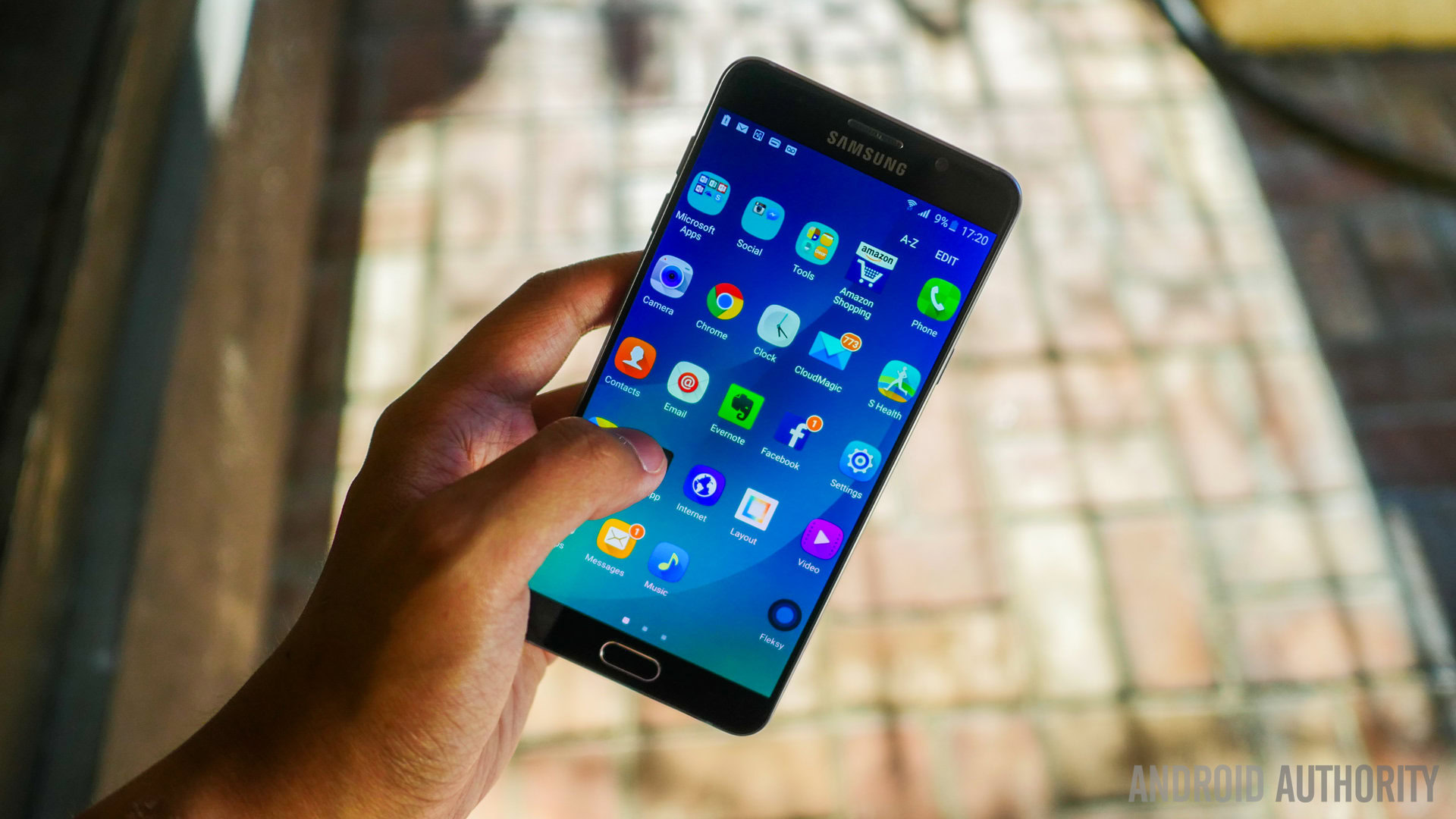
Software
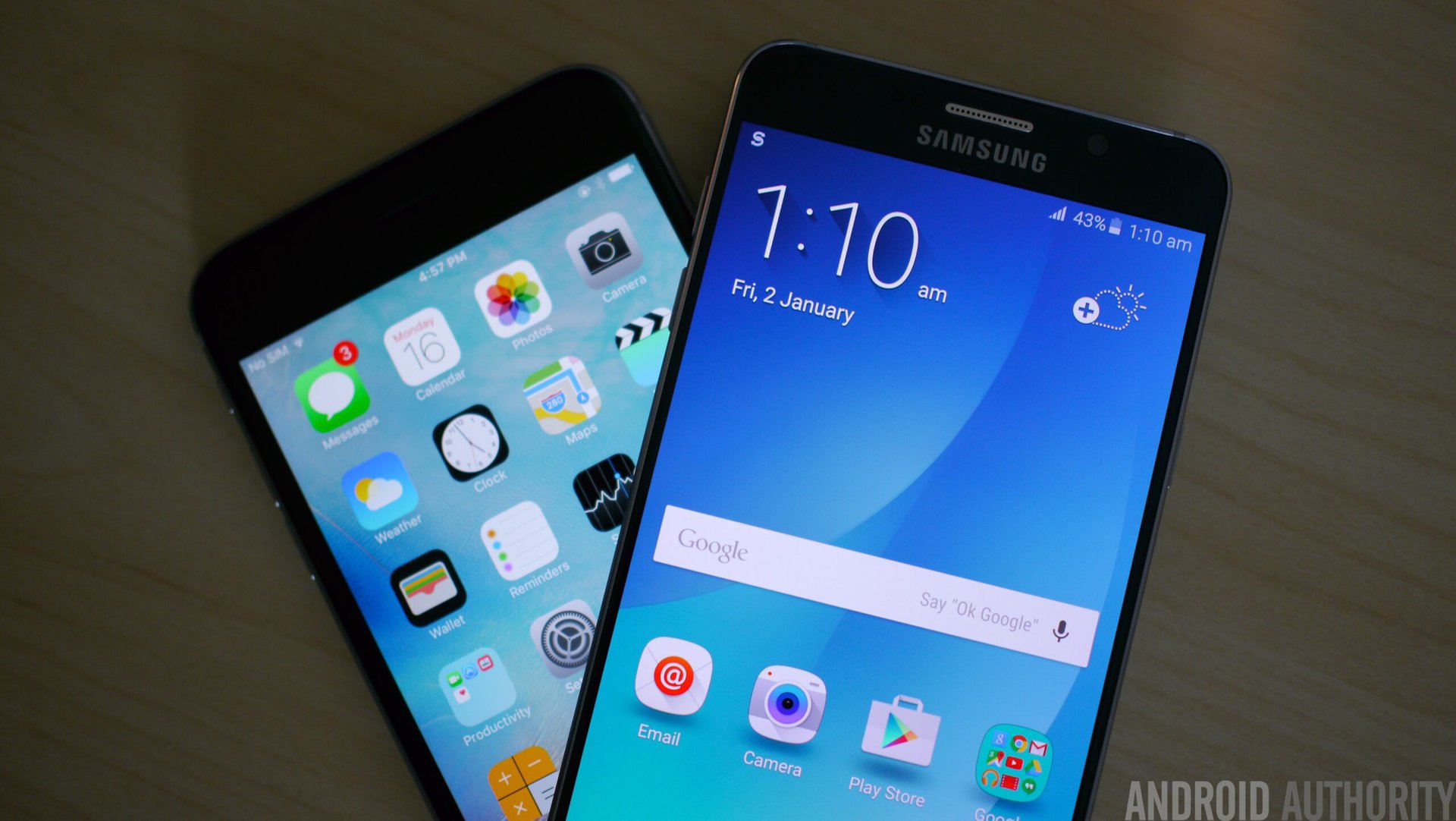
On the software side of things, we return to the age-old comparison between Android and iOS, and the two completely different ecosystems and experiences on offer. The iPhone 6S Plus runs iOS 9, while the Galaxy Note 5 comes with Android 5.1.1 Lollipop out of the box, and as always, simplicity vs customization is the name of the game here.
iOS is purposefully simple, and while Android users may feel limited by its simplicity, it is instead the most compelling aspect for Apple fans. The home screens remain grid of icons, with the only way to keep things somewhat free from getting too cluttered being folders. There have been a few additions over the last couple of years have made a difference, such as the notification dropdown, with a secondary screen can bring up a few extra shortcuts and glances at some contextual information, and a swipe up from the bottom opens the Control Center, where a number of controls and toggles are easily accessible. Of course, there is also 3D Touch now, which brings in an extra layer of functionality where applicable, while maintaining the aesthetically simplicity overall.
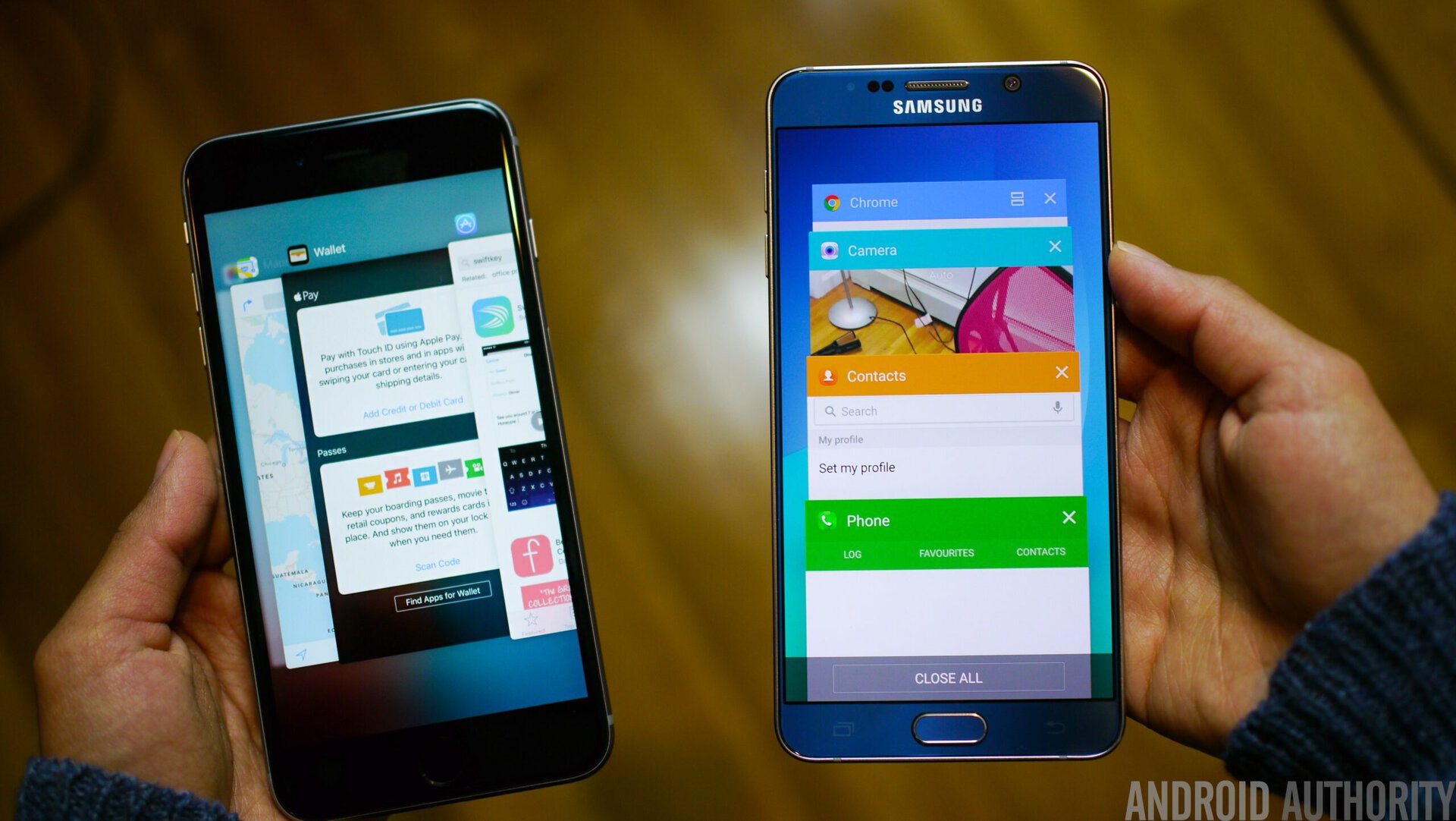
On the other hand is Samsung’s TouchWiz UI, a historically over-saturated software package, that has been toned down this year. That said, plenty of features do still make it in, including Multi-window and the floating S Windows for multi-tasking. Themes are also now available, allowing users to change the look of the interface if they don’t enjoy the default look. The main feature here is the S-Pen and all that it entails, including useful features like Action Memo, Smart Select, Screen Write, and Screen Off Memo.
Specs comparison
| Samsung Galaxy Note 5 | iPhone 6s Plus | |
|---|---|---|
Display | Samsung Galaxy Note 5 5.7-inch Super AMOLED display Quad HD resolution, 518 ppi | iPhone 6s Plus 5.5-inch IPS LCD display Full HD resolution, 401 ppi |
Processor | Samsung Galaxy Note 5 2.1 GHz octa-core Exynos 7420 Mali-T760MP8 GPU | iPhone 6s Plus 1.8 GHz dual-core Apple A9 PowerVR GT7600 GPU |
RAM | Samsung Galaxy Note 5 4 GB | iPhone 6s Plus 2 GB |
Storage | Samsung Galaxy Note 5 32/64 GB no expansion | iPhone 6s Plus 16/64/128 GB no expansion |
Camera | Samsung Galaxy Note 5 16 MP rear camera with OIS 5 MP front-facing wide angle lens camera | iPhone 6s Plus 12 MP rear camera with OIS 5 MP front-facing camera |
Connectivity | Samsung Galaxy Note 5 Wi-Fi 802.11 a/b/g/n/ac Bluetooth 4.2 GPS + GLONASS NFC USB 2.0 | iPhone 6s Plus a/b/g/n/ac Bluetooth 4.2 GPS + GLONASS NFC ( with Apple Pay only) USB 2.0 |
Software | Samsung Galaxy Note 5 Android 5.1.1 Lollipop | iPhone 6s Plus iOS 9 |
Battery | Samsung Galaxy Note 5 3,000 mAh | iPhone 6s Plus 2,750 mAh |
Dimensions | Samsung Galaxy Note 5 153.2 x 76.1 x 7.6 mm 171 grams | iPhone 6s Plus 158.2 x 77.9 x 7.3 mm 192 grams |
Gallery
Pricing and final thoughts
Both premium smartphones command equally premium price points, with the iPhone 6S Plus starting at $749 for the 16 GB iteration, with the available color options being space gray, silver, gold, and rose gold, while the Samsung Galaxy Note 5 priced at $699 for the 32 GB version, with the color options being Black Sapphire, Gold Platinum, Silver Titan, and White Pearl.
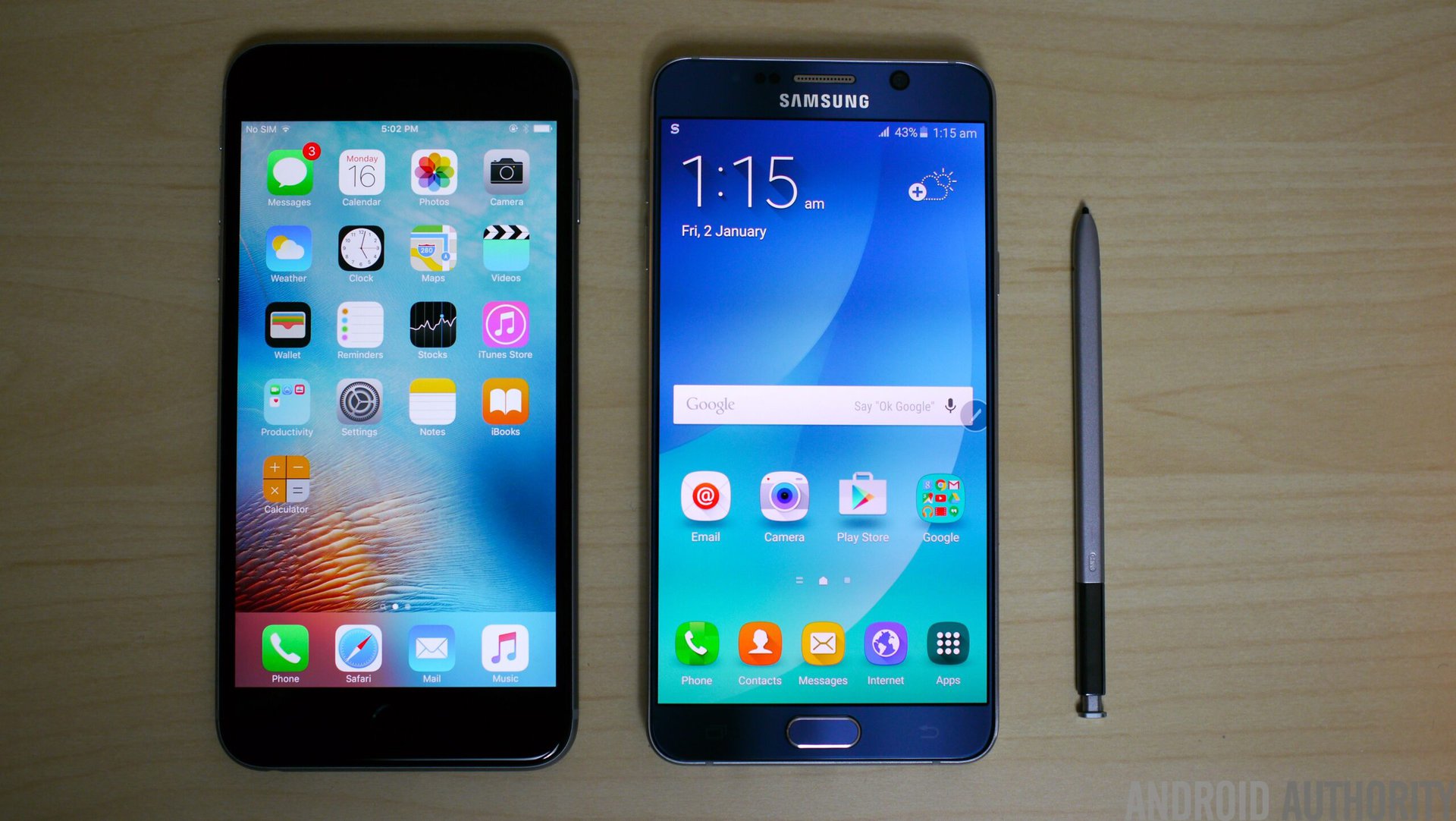
So there you have it for this in-depth look at the Samsung Galaxy Note 5 vs iPhone 6S Plus! It is certainly difficult to pick between these two smartphones, and with their differentiating factors coming down to personal preference, fans of one ecosystem will likely not be jumping ship. While the Galaxy Note 4 had its advantages over the iPhone 6 Plus in the form of expandable storage and a removable battery, things are lot more closer this time around. All said and done, if great performance and a fantastic camera experience is important to you, you will be happy regardless of which device you choose.